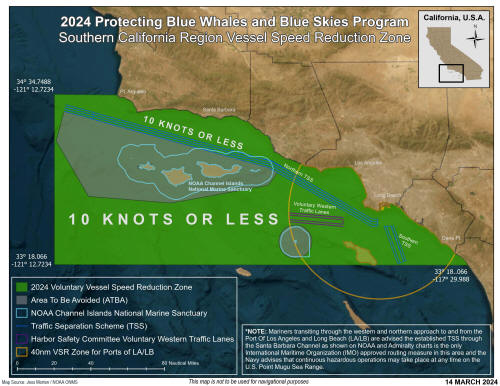Protecting Blue Whales and Blue Skies
Incentive Program

Holly Galbreath, Air Quality Specialist II (805) 303-3665
Tyler Harris, Planning, Rules and Incentives Manager (805)
303-3661
This program publicizes shipping companies’ efforts to
voluntarily reduce their speeds in the Santa Barbara Channel
and other areas of the California coast. It is a
collaborative effort among the Ventura County Air Pollution
Control District, other air districts, marine sanctuaries
and nonprofit organizations.
Vessels traveling in shipping lanes through the Santa
Barbara Channel are a significant source of air pollutants
in Ventura County, with prevailing winds carrying them
onshore. Reducing ship speeds decreases engine load and fuel
consumption, which cuts emissions of nitrogen oxides, diesel
particulate matter, sulfur compounds and greenhouse gases.
Since the program’s inception in 2014, participating vessels
have slowed down for more than 1.2 million miles (1.1
million nautical miles), resulting in emission reductions of
more than:
- 150,000 metric tons of greenhouse gases
- 4,500 tons of oxides of nitrogen
Slowing down also reduces the risk of fatal ship strikes to
whale and the volume of underwater noise.
The program runs from May to December to coincide with the
season when concentrations of ground-level ozone, or smog,
are typically high and whales are migrating and feeding in
the area. Automatic Identification System transponders
transmit ships’ speed and location data, which is analyzed
for each fleet.
History:
The district partnered with the Santa Barbara County Air
Pollution Control District, the National Oceanic and
Atmospheric Administration Channel Islands National Marine
Sanctuary and the Environmental Defense Center to launch the
program in 2014. It started in the Santa Barbara Channel
with seven shipping lines. In 2016, the U.S. Environmental
Protection Agency recognized the partnership’s 2014-15
efforts with a Clean Air Excellence Award.
The program has since spread to include more of the Southern
California coast and a region covering San Francisco and
Monterey bays.

The partnership has expanded to include the following:
- Bay Area Air Quality Management District
- Benioff Ocean Science Laboratory
- California Marine Sanctuary Foundation
- Monterey Bay Air Resources District
- National Oceanic and Atmospheric Administration Marine
Sanctuaries
- Santa Barbara County Air Pollution Control District
- San Luis Obispo County Air Pollution Control District
- Ventura County Air Pollution Control District
2023 Results:
Thirty-three global shipping companies participated and
slowed down to 11.5 miles (10 nautical miles) per hour or
less for a combined 432,000 miles (375,000 nautical miles).
This resulted in emission reductions of:
- 45,000 metric tons of greenhouse gases
- 1,250 tons of oxides of nitrogen
Among the 2023 participating fleets, the following 13
received the top-level Sapphire award for slowing down for
85% or more of the distance they traveled through the zones:
• CMA CGM
• CSL Group
• D'Amico Tankers DAC
• Hapag-Lloyd
• Mediterranean Shipping Co.
• NingBo Ocean Shipping Co.
• NYK Ro-Ro |
• Ocean Network Express
• Orient Overseas Container Line
• OSG Ship Management
• Swire Shipping
• Yang Ming
• Wallenius Wilhelmsen |
Ambassadors:
The following companies and ports have become program
ambassadors to demonstrate their commitment to shipping more
sustainably and reducing their supply chains’ negative
effects on biodiversity:
• Port of Hueneme
• JAS Worldwide
• Nomad
• Peak Design
• Santa Cruz Bicycles
• Sonos |
• Limoneira Co.
• Summit Coffee
• The Block Logistics
• Way Basics
• Who Gives a Crap
|
For more information:
Visit the
Protecting Blue Whales and Blue Skies website.



